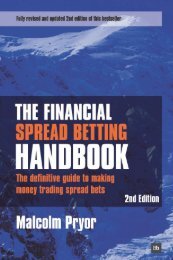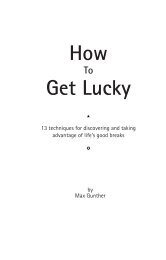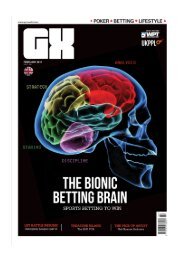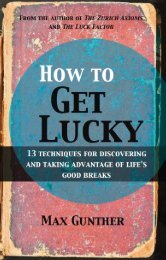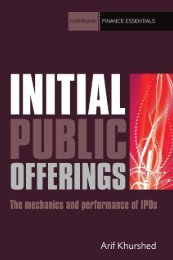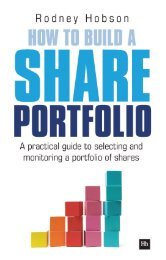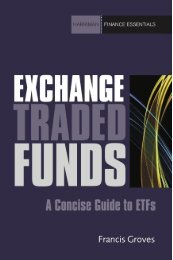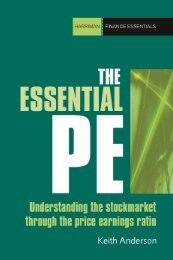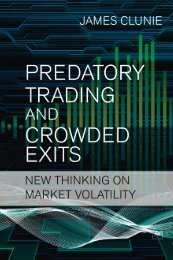Read a PDF Sample of Behavioural Technical ... - Harriman House
Read a PDF Sample of Behavioural Technical ... - Harriman House
Read a PDF Sample of Behavioural Technical ... - Harriman House
Create successful ePaper yourself
Turn your PDF publications into a flip-book with our unique Google optimized e-Paper software.
The <strong>Behavioural</strong> Finance Revolution<br />
In the case under consideration, that <strong>of</strong> buying a car, we as normal human beings<br />
are likely to do two things differently from Mr REM. First, we are unlikely to do as<br />
much research, analysis and calculation as Mr REM did. We are likely to keep things<br />
much simpler, making fewer mental calculations and comparisons. Otherwise things<br />
would get too complex.<br />
Second, we are likely to look at various emotional factors associated with the car.<br />
The brand, top speed, the shape <strong>of</strong> the model, the colours available, and the cachet<br />
associated with the vehicle may be important factors to many drivers. To many, a<br />
motor car is not simply a machine, but is <strong>of</strong>ten nearly a living thing. A car then is<br />
more than the sum <strong>of</strong> its parts and its function is much more than simply taking<br />
people and things from point A to point B.<br />
It is no wonder that an economic model which treats cars as simply transportation<br />
machines would not reflect all the essential characteristics <strong>of</strong> the real world and<br />
would have, as a consequence, limited utility in describing what is happening and<br />
in predicting the future. In a similar fashion, a financial model based on REM does<br />
not capture many <strong>of</strong> the real life and critical aspects <strong>of</strong> the market it is trying to<br />
explain. 1<br />
The beginnings <strong>of</strong> behavioural finance<br />
In various ways, the car example brings us to the heart <strong>of</strong> behavioural finance.<br />
<strong>Behavioural</strong> finance pioneers realised that while REM was a powerful concept, one<br />
that allowed the building <strong>of</strong> various useful economic theories, it did not capture<br />
enough <strong>of</strong> the truth – it did not capture real human beings with all the emotional<br />
baggage and personality humans posses.<br />
We all know that our emotions, such as fear and greed, and the emotions <strong>of</strong> others,<br />
especially if we are part <strong>of</strong> a crowd, creep surreptitiously into our decision-making<br />
and nudge us <strong>of</strong>f the logical path. Often it is only with hindsight that we realise how<br />
carried away we actually were. “What was I thinking!” we exclaim when it is too late.<br />
<strong>Behavioural</strong> finance pioneers felt that economics had to be re-examined and refined<br />
placing real, <strong>of</strong>ten irrational, <strong>of</strong>ten emotional, sometimes capricious, men and<br />
women at the centre.<br />
So, behavioural finance can be said to be about the replacement <strong>of</strong> homo<br />
economicus, or REM, by homo sapiens, real man, in economics. This re-examination<br />
<strong>of</strong> the nature <strong>of</strong> human beings as economic agents led to important critiques <strong>of</strong><br />
economic theory by Daniel Kahneman, Amos Tversky, Robert Shiller, Richard Thaler<br />
and others, which laid the groundwork for the development <strong>of</strong> behavioural finance.<br />
1 Please see Appendix 1 for a brief discussion <strong>of</strong> REM in the market.<br />
7



